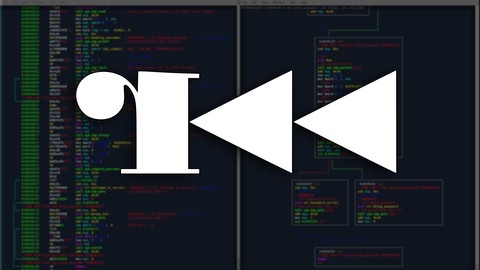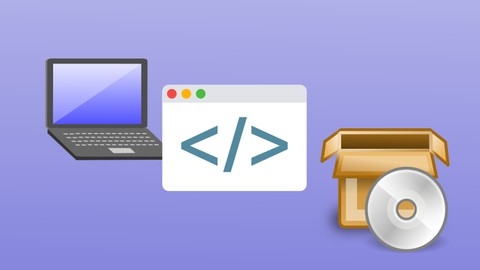Reverse engineering is the process of analyzing a system or program to understand its inner workings and potentially modify its behavior.
This skill is essential for security researchers, malware analysts, and anyone interested in understanding how software functions at a low level.
By learning reverse engineering, you can gain valuable insights into the design and implementation of software, identify vulnerabilities, and even create your own custom modifications.
Finding a comprehensive and engaging reverse engineering course on Udemy can be challenging, with so many options available.
You want a course that’s both informative and practical, taught by experienced professionals, and tailored to your learning style.
For the best reverse engineering course overall on Udemy, we recommend Reverse Engineering and Malware Analysis Fundamentals.
This course provides a solid foundation in both static and dynamic analysis techniques, covering everything from PE file structure to debugging malware with tools like Ghidra and xdbg.
The course features hands-on labs analyzing real malware samples, allowing you to apply your knowledge in a practical setting.
While this is our top pick, we understand that not everyone’s needs are the same.
There are many other great reverse engineering courses on Udemy, covering a wide range of topics and skill levels.
Continue reading to explore our recommendations for beginners, intermediate learners, and even those seeking to specialize in specific areas like .NET or mobile security.
Reverse Engineering and Malware Analysis Fundamentals
This course is your gateway to the fascinating world of reverse engineering and malware analysis.
You’ll start by building a solid foundation, setting up your own virtual machine environment with Windows 10 and essential tools like Flare VM.
This hands-on approach gets you comfortable with the tools of the trade before diving deeper.
You’ll then delve into the intricacies of the Portable Executable (PE) file, understanding its structure and how malware manipulates it.
This involves concepts like virtual memory, the Win32 API, and exploring both static and dynamic analysis techniques.
You’ll learn to wield tools like Ghidra for disassembling and decompiling code, while xdbg helps you debug malware in action.
Theory alone isn’t enough, so you’ll apply your knowledge through practical labs analyzing real malware samples.
Starting with simpler examples, you’ll graduate to tackling complex threats like TeslaCrypt ransomware and the Simda Trojan.
You’ll learn to identify packers, unpack them, and utilize techniques like Procdot and network analysis to understand how these malicious programs operate.
Reverse Engineering and Exploit Development
This comprehensive course takes you on a deep dive into the world of reverse engineering and exploit development.
Starting with the basics of dissecting compiled applications, you’ll learn to wield powerful tools like debuggers and disassemblers.
The curriculum guides you through identifying vulnerabilities like stack overflows, heap overflows, and format string bugs across Windows, OS X, and Linux platforms.
You’ll then transition into the fascinating realm of exploit development, mastering the techniques to turn those vulnerabilities into working exploits.
You’ll explore the intricacies of shellcode, discover ways to encode it to evade detection, and learn how to build your own Metasploit modules.
The course also ventures into the specific challenges of Android exploitation, delving into the ARM architecture and guiding you through the process of crafting exploits for this mobile platform.
Expert Malware Analysis and Reverse Engineering
This course is a comprehensive deep dive into the world of malware analysis and reverse engineering, equipping you with the knowledge and skills to effectively combat these threats.
You’ll start by understanding the “Cyber Kill Chain,” a framework that outlines the steps attackers take to compromise systems, providing you with a strategic foundation for your analysis.
The course doesn’t just provide theory – you’ll get hands-on with setting up your own malware lab using powerful tools like REMnux, a Linux distribution specifically designed for security professionals.
This practical experience will allow you to analyze malicious files, including those sent through spearphishing emails, and gain a thorough understanding of how these files are weaponized.
You’ll also learn to dissect Microsoft Office documents and PDF files, uncovering the methods attackers use to exploit these common formats.
Moving beyond file analysis, you’ll delve into network-based analysis, learning to use Wireshark to capture and analyze network traffic.
You’ll learn how to identify and understand exploit kits, gaining valuable insights into how attackers exploit vulnerabilities and compromise systems.
Finally, you’ll explore the intricate workings of Portable Executable files, the format used for most Windows programs.
You’ll gain a deep understanding of their structure, execution, and compilation, providing you with a fundamental knowledge of how programs operate at a low level.
You’ll also be introduced to static malware analysis tools, enabling you to analyze programs without actually running them, allowing you to detect threats proactively.
You’ll be equipped to analyze and understand the tactics used by attackers, enabling you to effectively mitigate threats and protect your organization’s systems.
Mobile Security: Reverse Engineer Android Apps From Scratch
You’ll begin by mastering the fundamentals of Android development, setting up your environment, and familiarizing yourself with essential tools like Android Studio and the SDK Manager.
The course then dives into the practical application of reverse engineering tools, such as Apktool, JD-GUI, Bytecodeviewer, Androguard, Objection, and Tamer.
These tools allow you to dissect Android apps, revealing their inner workings and uncovering potential vulnerabilities.
You’ll gain hands-on experience by building a simple Android app, gaining a deeper understanding of the core components like Activities, Content Providers, Broadcast Receivers, and Services.
This practical experience serves as a foundation for your reverse engineering journey, allowing you to apply your knowledge to real-world applications.
The course progresses to explore various analysis techniques, starting with static analysis using tools like Apktool and Bytecodeviewer, where you’ll examine the app’s code without actually running it.
You’ll then delve into dynamic analysis using Objection, allowing you to observe the app’s behavior in real-time.
The curriculum also covers automated analysis with malware sandboxes, a crucial technique for detecting malicious behavior in Android apps.
The course culminates in a captivating case study involving real ransomware called Simplocker.
You’ll apply your accumulated knowledge to analyze this malicious software, understanding its operation and even developing a decryption tool to recover stolen data.
Reverse Engineering 1: x64dbg Debugger for Beginners
You’ll learn the ins and outs of x64dbg, a powerful debugger, equipping you with the tools to analyze software like a detective investigating a complex case.
The course starts by guiding you through setting up your reverse engineering environment with essential tools like x64dbg and Detect It Easy.
You’ll then dive into hands-on practice with “CrackMe’s,” intriguing mini-challenges designed to sharpen your reverse engineering skills.
These CrackMe’s will become your playground, helping you master x64dbg to analyze code, identify hidden mechanisms, and ultimately understand how software functions.
You’ll embark on a journey through assembly language, the language that underpins all software.
Through guided exploration with the debugger, you’ll learn to navigate this code, uncovering its secrets.
You’ll master breakpoints, allowing you to pause the program at strategic points, enabling you to dissect its behavior and understand its workings.
You’ll also learn to trace the flow of code, analyzing jumps to understand how program execution branches and evolves.
You’ll discover how to patch programs to modify their functionality, effectively making targeted adjustments.
You’ll even learn to create your own patches using jumps, giving you the power to customize and enhance software.
This course provides a strong foundation in reverse engineering, empowering you to confidently explore the hidden depths of software and unlock its secrets.
Learn Ethical Hacking & Reverse Engineering
This “Learn Ethical Hacking & Reverse Engineering” course offers a comprehensive introduction to cybersecurity, covering both foundational principles and more advanced hacking techniques.
You’ll begin with an exploration of common vulnerabilities, like information leaks and path traversal, learning how to analyze HTML tags and JavaScript code for security flaws.
As you progress, the course delves into more complex concepts.
You’ll gain hands-on experience using tools like “Detect It Easy” (DIE) to understand how software works, enabling you to identify and exploit weaknesses.
The syllabus highlights a diverse range of hacking techniques, including:
-
SQL Injection: Learn how to bypass logins and access sensitive data by exploiting vulnerabilities in databases.
-
Reverse Engineering: You’ll explore methods for cracking encryption algorithms and uncovering hidden information within seemingly secure systems.
-
Steganography: Discover how to conceal messages within seemingly innocuous files like images and audio recordings.
-
Password Reminder Exploits: Learn how to manipulate password reset mechanisms to gain unauthorized access.
-
Automated Hacking: You’ll use tools like “AutoIt” and “Node.js” to automate tasks and bypass security measures, which are crucial skills for any ethical hacker.
The course also dedicates a significant portion to software cracking.
You’ll learn to use debuggers like “x64dbg” to analyze software behavior, identify security flaws, and find ways to bypass protective measures.
You’ll explore essential concepts like Windows API functions and the stack, gaining valuable insights into the inner workings of software development.
You’ll even learn how to patch software, a skill often sought after in ethical hacking and security research.
While the course offers a broad range of topics, keep in mind that some subjects might require prior knowledge or technical experience.
If you’re new to ethical hacking, it’s essential to understand the legal and ethical implications of your actions.
Ensure you’re familiar with the principles of ethical hacking and that you’re using your skills responsibly.
This course can provide a strong foundation for those looking to delve deeper into the world of ethical hacking and reverse engineering.
The comprehensive curriculum and practical hands-on exercises will equip you with the knowledge and skills to pursue a career in this exciting and ever-evolving field.
Reverse Engineering .NET For Beginners (Visual Basic)
If you’re interested in diving into the world of reverse engineering, this course offers a structured introduction to the .NET framework.
It focuses on Visual Basic.NET, a popular language within this framework, and provides hands-on experience with essential tools like debuggers and disassemblers.
The course takes a practical approach, starting with basic programs and gradually increasing complexity.
You’ll learn to reverse engineer various code structures, from simple functions to more intricate algorithms.
The instructors guide you through each step, explaining the techniques and concepts behind the process.
Through analyzing real-world programs, you’ll gain a deeper understanding of how software is built and how it can be dissected.
This course provides a solid foundation in reverse engineering principles, equipping you with the skills to analyze your own applications or delve into the inner workings of others.
Reverse Engineering & Malware Analysis - Intermediate Level
This course provides a solid foundation in practical malware analysis, diving deep into the techniques you’ll need to understand and dismantle malicious software.
You’ll start with a grounding in the different types of malware and the terminology used by professionals.
The course then takes you through a series of hands-on labs, allowing you to analyze real-world malware samples.
You’ll learn how to use powerful tools like IDA Pro and xdbg to dissect the code, identify malicious functions, and trace execution flow.
One of the course’s strengths lies in its comprehensive coverage of unpacking techniques.
You’ll be equipped to analyze packed malware, such as those using UPX or VMProtect, and expose the hidden malicious code.
The course utilizes various techniques like API hooking, memory dumping, and process tracing, giving you a practical understanding of how these methods are applied.
You’ll gain hands-on experience unpacking a range of Trojans, including Emotet, Hancitor, Trickbot, and Dridex.
Each lab provides a detailed walkthrough, guiding you step-by-step through the analysis process.
Beyond unpacking, the course covers essential concepts like assembly language, API hooking, process hijacking, and memory dumping, providing a deeper understanding of how malware operates.
You’ll also learn to use popular tools like PE-Studio, PE-Bear, and dnSpy, which are essential for malware analysis.
You’ll be equipped to analyze various types of malware, understand their functionalities, and develop countermeasures to protect systems from these threats.
Reverse Engineering with Radare 2
This course provides a solid introduction to the world of reverse engineering using Radare 2.
If you’re new to this field, you’ll find the step-by-step approach valuable.
You’ll start with the fundamentals, learning how to download and set up Radare 2, ensuring you have a comfortable environment to work in.
The course then dives into the core of reverse engineering, exploring how to analyze binaries and understand their structure.
You’ll gain practical skills in navigating through code, identifying cross-references, and decoding the program’s internal logic.
One of the course’s strengths is its emphasis on runtime debugging.
You’ll learn how to use Radare 2 to watch program execution in real-time, offering a deeper understanding of how the code actually behaves.
This hands-on experience is crucial for developing your reverse engineering intuition.
The course also introduces patching, allowing you to make modifications to the program to test your understanding or alter its behavior.
This practical application further reinforces your grasp of the underlying principles.
To enhance visualization and simplify complex concepts, you’ll be introduced to Cutter, the graphical user interface for Radare 2.
Cutter provides a visual representation of program structure, making it easier to understand the relationships between different parts of the code.
A dedicated challenge section allows you to apply your newfound skills in a practical context, testing your understanding and building confidence.
While the course provides a strong foundation, you should be prepared to invest additional time and effort to delve deeper into the intricacies of reverse engineering.
It serves as a great starting point, providing the necessary tools and knowledge to embark on your reverse engineering journey.
Reverse Engineering 6: Reversing .NET with dnSpy
You’ll learn to decompile, analyze, and modify .NET applications, starting with the fundamentals of .NET programs and progressing through practical exercises.
The course’s strength lies in its hands-on approach.
You’ll get immediate experience with dnSpy by exploring a crackme program, a classic exercise for learning reverse engineering techniques.
This experience will guide you as you learn to patch code, manipulate program flow, and understand common .NET security vulnerabilities.
Beyond basic techniques, the course delves into advanced concepts like serial phising, allowing you to identify and exploit security weaknesses in software.
You’ll even create your own C# keygen, gaining a deeper understanding of how software protection mechanisms work.
The course also covers popular .NET protection methods, such as ConfuserEx and Confuser 1.9.
You’ll learn to deobfuscate these methods, uncovering the hidden code beneath the protection layers.
This practical experience is essential for anyone seeking to analyze and potentially circumvent software protection techniques.
While the course offers a solid foundation in .NET reverse engineering, it’s crucial to remember that the field is constantly evolving.
The course lays a strong foundation for you to continue learning and explore advanced topics, tools, and techniques.










